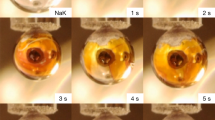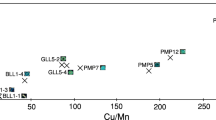The chemistry of the magic ingredient in this ancient glass is no longer a mystery.
Abstract
The red colour of gold-ruby glass is caused by small particles of metallic gold that form when the gold-containing colourless glass is annealed. But the chemical state of the gold before striking red has been a mystery — is it dissolved in the glass as individual neutral gold atoms, like a frozen-in metal vapour that precipitates on annealing1, or as gold cations that must be reduced before the metallic clusters can grow and impart the lustrous colour2,3? Here we use Mössbauer spectroscopy to show that this gold is monovalent in the colourless glass, forming linear bonds to two neighbouring oxygen atoms.
This is a preview of subscription content, access via your institution
Access options
Subscribe to this journal
Receive 51 print issues and online access
$199.00 per year
only $3.90 per issue
Buy this article
- Purchase on Springer Link
- Instant access to full article PDF
Prices may be subject to local taxes which are calculated during checkout

BRITISH MUSEUM

Similar content being viewed by others
References
Weyl, W. A. Coloured Glasses 380–400 (Society of Glass Technology, Sheffield, 1951).
Badger, A. E., Weyl, W. & Rudow, H. Glass Ind. 20, 407–414 ( 1939).
Stookey, S. D. J. Am. Ceram. Soc. 32, 246–249 (1949).
Barber, D. J. & Freestone, I. C. Archaeometry 32 , 33–45 (1990).
Frank, S. Glass Technol. 25, 47–50 (1984).
Williams, J. A., Rindone, G. E. & McKinstry, H. A. J. Am. Ceram. Soc. 64, 709 –713 (1981).
Parish, R. V. in Mössbauer Spectroscopy Applied to Inorganic Chemistry Vol I (ed. Long, G. J.) 577–617 (Plenum, New York, 1984).
Wasel-Nielen, H.-D & Hoppe, R. Z. Anorg. Allg. Chem. 359, 36–40 ( 1968).
Wagner, G. & Hoppe, R. Z. Anorg. Allg. Chem. 549, 26–34 (1987).
Faltens, M. O. & Shirley, D. A. J. Chem. Phys. 53, 4249–4264 ( 1970).
Rao, P. & Doremus, R. J. Non-Cryst. Solids 203, 202–205 (1996).
Author information
Authors and Affiliations
Rights and permissions
About this article
Cite this article
Wagner, F., Haslbeck, S., Stievano, L. et al. Before striking gold in gold-ruby glass. Nature 407, 691–692 (2000). https://doi.org/10.1038/35037661
Issue Date:
DOI: https://doi.org/10.1038/35037661
This article is cited by
-
Crystal-chemical origins of the ultrahigh conductivity of metallic delafossites
Nature Communications (2024)
-
Controlled formation of gold nanoparticles with tunable plasmonic properties in tellurite glass
Light: Science & Applications (2023)
-
New opportunities and old challenges in the clinical translation of nanotheranostics
Nature Reviews Materials (2023)
-
Noble metals Pt, Au, and Ag as nucleating agents in BaO/SrO/ZnO/SiO2 glasses: formation of alloys and core–shell structures
Journal of Materials Science (2022)
-
Effect of SnO2/SeO2 on Au nano-particles doped silicate glasses: a structural study using XAS and EXAFS refinements
Optical and Quantum Electronics (2020)
Comments
By submitting a comment you agree to abide by our Terms and Community Guidelines. If you find something abusive or that does not comply with our terms or guidelines please flag it as inappropriate.



